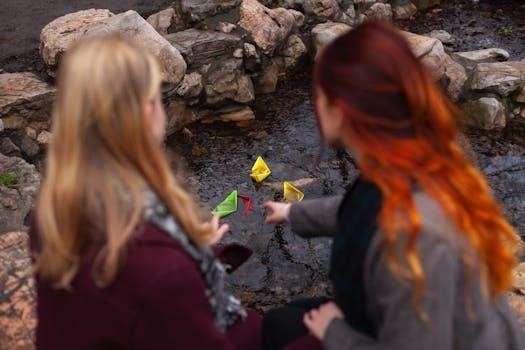Overview of “Woman Hollering Creek”
Sandra Cisneros’ “Woman Hollering Creek” is a rich and complex story that delves into the struggles of a woman trapped by patriarchal culture. The narrative explores themes of identity, domestic abuse, and romantic love. It uses characterization, conflict, and setting effectively. The story follows Cleofilas’ journey of self-discovery.
Sandra Cisneros’ “Woman Hollering Creek” is a poignant short story that examines the life of Cleófilas, a Mexican woman navigating the complexities of marriage and cultural expectations. The narrative begins with Cleófilas’ father granting permission for her to marry Juan Pedro, setting the stage for her journey. Cisneros masterfully uses the setting of a seemingly pretty creek with an ominous name, “Woman Hollering Creek,” to foreshadow the emotional turmoil and struggles that Cleófilas will face. The story delves into the heart of a patriarchal society, portraying how traditional gender roles can confine women. Cisneros uses characterization, conflict, and symbolism to highlight the power dynamics within the Hispanic culture and the challenges women face in finding their voices. Furthermore, the story explores romantic ideals versus the harsh realities of domestic life, and it emphasizes the necessity of female support. Through Cleófilas’ experiences, Cisneros offers insights into the Mexican-American experience and the quest for self-identity.
The Real-Life Location of Woman Hollering Creek
The setting of Sandra Cisneros’ story, “Woman Hollering Creek,” is not just a fictional backdrop, but rather a real waterway located near San Antonio, Texas. This arroyo, or creek, with its evocative name, adds a layer of depth and symbolism to the narrative. The physical location serves as a tangible representation of the cultural context and the emotional landscape of the story. The creek’s name, drawn from a Mexican indigenous legend of a wailing woman who drowned her children, becomes a powerful motif that reflects the tragic elements within the story. Cisneros uses this real-world setting to ground her narrative and make it more relatable. The creek is not merely a place; it is a symbol of transition and the crossing into a new, yet unsettling life for the main character. The geographical reality of the creek enhances the story’s exploration of themes of identity, cultural heritage, and female suffering, making it a critical element in understanding the complex layers of the narrative.

Themes and Analysis
This story explores patriarchal culture, male dominance, and the struggle for female identity. It delves into domestic abuse and contrasts romantic ideals with familial realities. The narrative also examines the Mexican-American experience.
Patriarchal Culture and Male Dominance
In “Woman Hollering Creek,” Sandra Cisneros vividly portrays the pervasive influence of a patriarchal culture on women’s lives. The narrative exposes how men, like Cleófilas’ father, Don Serafín, and her husband, Juan Pedro, wield significant control over women’s choices and destinies. This dominance is evident from the beginning, where Cleófilas’ marriage is arranged, highlighting women’s lack of autonomy in such decisions. The story further illustrates how this male-dominated structure perpetuates a cycle of abuse, where women are often seen as possessions rather than individuals with their own desires and aspirations. The characters’ interactions within the story reveal the deeply ingrained power imbalance, showcasing how men’s actions and decisions shape the experiences of the women around them. This theme underscores the societal constraints that limit women’s freedom and agency, forcing them to conform to traditional roles. The narrative emphasizes the need for resistance against such structures.
The Struggle for Female Identity and Voice
Within the confines of a patriarchal society, “Woman Hollering Creek” explores the difficult journey women undertake to establish their identities and assert their voices. Cleófilas, initially passive and compliant, grapples with the dissonance between her romantic ideals and the harsh realities of her marriage. The narrative showcases how women’s sense of self is often suppressed by societal expectations and male dominance, leaving them feeling voiceless and insignificant. The story highlights the internal struggles women face as they seek to define themselves beyond their prescribed roles as wives and mothers. This quest for identity is intertwined with their fight to be heard and respected, which is often met with resistance. The text illustrates both acceptance of and rebellion against gendered expectations, showing the complexities of women’s journey toward self-discovery and agency. The women in the story ultimately push back against male dominance.
Exploration of Domestic Abuse
“Woman Hollering Creek” unflinchingly portrays the harsh realities of domestic abuse, shedding light on its physical and emotional toll on women. The story illustrates how cultural norms and male dominance create an environment where abuse can thrive, often leaving victims feeling trapped and helpless. Cleófilas’ marriage to Juan Pedro serves as a stark example of this, showcasing the cycle of violence and control. The narrative doesn’t shy away from depicting the subtle ways abuse can manifest, highlighting how it erodes a woman’s self-worth and sense of agency. The story also reveals how the community’s silence and complicity can further isolate victims, making it harder for them to escape. Cisneros uses her narrative to expose the devastating consequences of domestic violence and to challenge the systems that perpetuate it. The reader is confronted with the realities and the impact on individual lives.
Romantic Love vs. Familial Love
In “Woman Hollering Creek,” Sandra Cisneros explores the complex dichotomy between romantic ideals and the realities of familial love, or the lack thereof. Cleófilas’ initial perception of romantic love, fueled by telenovelas, contrasts sharply with the harsh reality of her marriage to Juan Pedro. Her pursuit of romantic love leads her away from her family and into a situation where she is isolated and abused, highlighting the dangers of romanticizing relationships. The story also subtly examines the complexities of familial bonds, revealing that not all families offer the support and security one might expect. The narrative juxtaposes Cleófilas’ idealized vision of love with the often-disappointing realities of both romantic relationships and family dynamics, prompting readers to question conventional notions. It emphasizes the need for a more balanced perspective on love and relationships, where both romantic and familial connections are examined critically.

Character Analysis
The story uses detailed characterization to portray Cleófilas’ journey. The narrative also explores the impact of other female characters on her life. These characters both challenge and support her experiences and development.
Cleófilas’ Journey of Self-Discovery
Cleófilas’ journey in “Woman Hollering Creek” is central to the narrative, showcasing her transformation from a naive young woman to one who acknowledges her circumstances. Initially, she is portrayed as someone who is heavily influenced by cultural expectations and romantic ideals, dreaming of a love akin to that in telenovelas. Her marriage, arranged by her father, takes her away from her family to a new life that quickly becomes a source of disappointment and abuse. The creek, ironically named “Woman Hollering,” becomes a symbol of her internal struggles and the cries she cannot voice. Through her interactions with other women, she begins to understand the reality of her situation and the possibilities of female solidarity and support. Her growing awareness propels her towards seeking change and ultimately making the decision to leave her oppressive marriage. This journey is a gradual process of self-realization and empowerment. Her experiences provide a profound understanding of her own strength.
The Impact of Other Female Characters
In “Woman Hollering Creek,” the female characters play a crucial role in Cleófilas’ journey, offering both contrasting perspectives and vital support. These women, often overlooked in the patriarchal setting, become catalysts for her self-discovery. Characters like Felice, who drives the truck, represent female independence and challenge traditional gender roles. By contrast, the women in Cleófilas’ past, including her mother, illustrate the limited options available to women in her culture. These contrasting portrayals contribute to Cleófilas’ growing awareness of her own potential and the possibility of breaking free from her constricting circumstances. The solidarity among these women becomes a powerful force, highlighting the significance of female bonds. These interactions demonstrate how women can offer support, challenge societal norms, and ultimately impact one another’s lives. The female characters, through their actions and experiences, help Cleófilas to see beyond her immediate situation.

Narrative and Style
The story is predominantly told using a third-person omniscient narrator, which allows access to Cleófilas’ thoughts and feelings. Cisneros uses rich symbolism and vivid imagery, enhancing the story’s emotional depth and cultural context.
Third-Person Omniscient Narration
Sandra Cisneros employs a third-person omniscient narrative voice in “Woman Hollering Creek,” granting the reader access to the inner thoughts and feelings of multiple characters, particularly Cleófilas. This narrative perspective allows the reader to understand the complexities of her situation, beyond what she might outwardly express. We are privy to her romantic dreams, her growing disillusionment, and her eventual desire for escape. The narrator knows Cleófilas’ past in Mexico, her interactions with her family, and her perceptions of her new life. This perspective isn’t limited to her, however; it also provides glimpses into the thoughts and motivations of other characters, enriching the narrative and allowing for a more comprehensive exploration of the story’s themes. The narrator’s broad view helps to highlight the cultural dynamics and societal pressures impacting Cleófilas’ life. This narrative style is crucial in conveying the full impact of her experiences and struggles within the patriarchal structure.
Use of Symbolism and Imagery
In “Woman Hollering Creek,” Sandra Cisneros masterfully employs symbolism and imagery to deepen the story’s meaning. The creek itself is a central symbol, its name echoing the legend of La Llorona, representing both the wailing of a suffering woman and the potential for danger and despair. The act of crossing the creek symbolizes Cleófilas’ transition into marriage and her new life. The imagery of the telenovelas that Cleófilas is obsessed with represents the romantic ideals she holds, juxtaposed with the stark reality of her life. The color of her house and its stifling environment reflect her emotional state. The use of specific details, such as the way Juan Pedro treats her, creates powerful images of her oppression and isolation. The constant references to the sounds and sights surrounding Cleófilas underscore her sense of being trapped within her circumstances. These symbolic elements and vivid images enrich the narrative, adding layers of meaning to Cleófilas’ experience.

Cultural Context
The story is deeply rooted in the Mexican-American experience, exploring gender roles and the impact of cultural expectations. It also references the legend of La Llorona, adding a layer of folklore.
Mexican-American Experience
“Woman Hollering Creek” provides a poignant glimpse into the lives of Mexican-American women, particularly within the context of traditional gender roles and expectations. The narrative highlights the cultural pressures and constraints experienced by these women, often navigating between two worlds – their Mexican heritage and the American society they inhabit. The story portrays the challenges of maintaining cultural identity while encountering societal norms that may differ significantly from their upbringing. The story also touches upon the themes of family dynamics, marital expectations, and the limited agency often granted to women within this cultural framework. It reveals the struggles these women face, including domestic abuse and a lack of personal freedom, while also showcasing their resilience and capacity for hope. Cisneros’ work offers a powerful commentary on the cultural complexities of the Mexican-American experience.
The Legend of La Llorona
The story of “Woman Hollering Creek” is deeply intertwined with the Mexican legend of La Llorona, a wailing woman who drowned her children. This legend serves as a powerful backdrop, influencing the narrative’s themes and adding a layer of cultural significance. The creek itself is named after this haunting figure, and the story makes a direct comparison between La Llorona and the protagonist Cleófilas’ own situation as a woman trapped in an unhappy marriage. The reference to La Llorona evokes feelings of sorrow, loss, and despair, further emphasizing the struggles faced by women within the patriarchal society depicted in the story. This connection provides a symbolic framework for understanding the protagonist’s emotional state and her desperate need for escape from her own suffocating circumstances. The legend’s presence enriches the narrative by blending folklore with the harsh realities of a woman’s life.